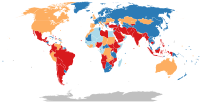
Photo from wikipedia
Aim We examined the anxiety levels and coping strategies among staff and students of a tertiary educational institution during the COVID-19 pandemic and determined the association between anxiety level and… Click to show full abstract
Aim We examined the anxiety levels and coping strategies among staff and students of a tertiary educational institution during the COVID-19 pandemic and determined the association between anxiety level and coping strategies. Method Through an online survey, we used Coronavirus Anxiety Scale (CAS) to measure the level of anxiety associated with the COVID-19 crisis and Brief Coping Orientation to Problems Experienced (COPE) to assess the coping responses adopted to handle stressful life events. Coping strategies were classified as adaptive and maladaptive, for which the aggregate sores were calculated. Multiple linear regression was used to determine the predictors of anxiety adjusted for potentially confounding variables. Results from 434 participants were available for analysis. Results The mean score (SD) of the CAS was 1.1 (1.8). The mean scores of adaptive and maladaptive coping strategies were 35.69 and 19.28, respectively. Multiple linear regression revealed that maladaptive coping [Adjusted B coefficient = 4.106, p-value < 0.001] and presence of comorbidities [Adjusted B coefficient = 1.376, p-value = 0.025] significantly predicted anxiety. Conclusion Maladaptive coping and presence of comorbidities were the predictors of coronavirus anxiety. The apparent lack of anxiety in relation to COVID-19 and movement restriction is reflective of the reported high level of satisfaction with the support and services provided during the COVID-19 outbreak in Malaysia. Adaptive coping strategies were adopted more frequently than maladaptive. Nevertheless, public education on positive coping strategies and anxiety management may be still be relevant to provide mental health support to address the needs of the general population.
Journal Title: Frontiers in Public Health
Year Published: 2022
Link to full text (if available)
Share on Social Media: Sign Up to like & get
recommendations!